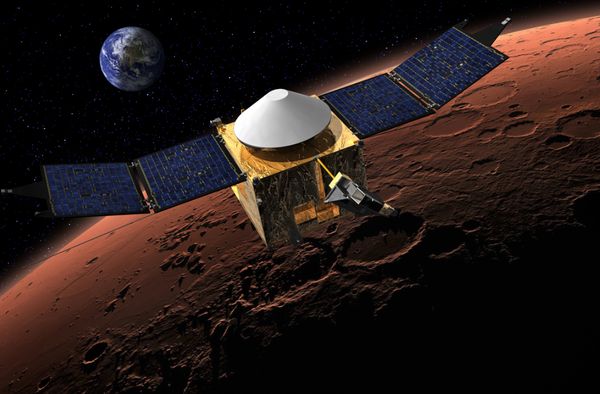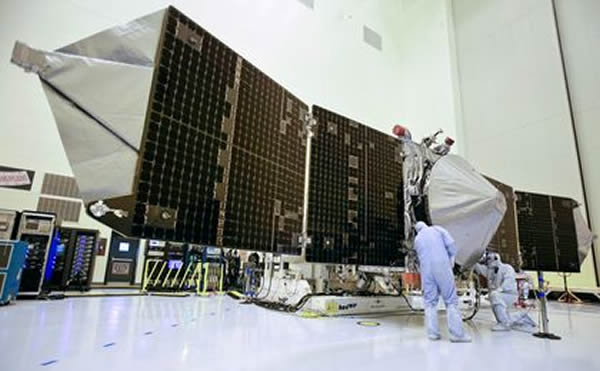NASA's Next Mars Mission: Five Things to Know
An artist's concept shows the MAVEN spacecraft—set to launch in November—in orbit around the Red Planet.
NASA's next Mars mission aims to uncover the red planet's ancient atmosphere. The Mars Atmosphere and Volatile Evolution Mission, or MAVEN, will launch on November 18, weather permitting, for a ten-month trip to Mars.
Here are five things to know about the $671 million mission to the planet that most looks like Earth, and that some hope still harbors life:
1. MAVEN is an orbiter, not a rover.
The space agency has two rovers, Opportunity and Curiosity, rolling on the red planet right now. MAVEN will instead circle the planet some 106 miles (170 kilometers) above the Martian surface.
High above the red planet, MAVEN will turn its instruments to the planet's upper atmosphere. The goal is to see how quickly the sun's solar wind strips water and carbon dioxide away from the planet.
Over a Martian year, the team hopes to see the effects of solar storms and the solar wind upon the atmosphere, says mission chief scientist Bruce Jakosky of the University of Colorado, Boulder.
2. Mars once had a warm and wet atmosphere.
MAVEN's mission is to rediscover what atmospheric conditions once allowed the existence of the lakes, rivers, and seas that left their traces left on the Martian surface. They are thought to date from several billion years ago.
NASA's Curiosity rover, for example, last year reported evidence that it had landed in an ancient riverbed inside Gale Crater on Mars, where water once ran waist-high.
"It's clear there are many questions about Mars that center on the history of its atmosphere," Jakosky says. For example, what exactly happened to the thicker, carbon dioxide-rich atmosphere that once sheltered those lakes and rivers?
3. The spacecraft won't find Martians.
A lot of the hopes about microbes living under the Martian surface rode on reports that methane gas was surprisingly common in the planet's atmosphere. But MAVEN won't be looking for methane.
It might be just as well; recent Curiosity rover surface readings have cast doubt on the methane findings.
To keep the mission focused and costs down, Jakosky said the spacecraft will concentrate instead on carbon dioxide and water vapor, the two most important gases for understanding the atmosphere's past.
Technicians work on NASA’s next Mars-bound spacecraft, the Mars Atmosphere and Volatile Evolution (MAVEN) at the Kennedy Space Center.
Mars's atmosphere is very thin, less than one percent of the thickness of Earth's at sea level. And its chief gas is carbon dioxide, which is about 95 percent of the red planet's atmosphere. Carbon dioxide is a greenhouse gas, and when it was thick on Mars it likely provided an insulation blanket that helped maintain those long-vanished rivers and seas.
4. MAVEN will carry Earthlings' names to Mars.
Pinned to one of the spacecraft's solar panels is a DVD with the names of a hundred thousand Mars fans, as well as an elementary school's class project, the winner of a Mars travel contest. The kids told NASA what they would like to take to Mars someday.
The DVD will also carry contest-winning haiku written by folks interested in the mission. Here's one winner from Greg Pruett, a U.S. contestant:
distant red planet
the dreams of earth beings flow
we will someday roam
The space agency received 12,530 haiku entries in the contest. Who says poetry is dead?
5. The orbiter will keep other Mars spacecraft going.
One reason that NASA deemed the launch of the spacecraft essential during the recent U.S. government shutdown is that it will serve as a long-lived communications relay for rovers and other spacecraft orbiting Mars. NASA plans to send another rover like Curiosity to the red planet in 2020.
Spending the money to send the MAVEN orbiter to Mars is a sign of the space agency's commitment to Mars exploration, said NASA science chief John Grunsfeld, speaking at a briefing on the mission on October 28.
Whatever the mission finds, it will likely be interesting, he added, endorsing the slow and steady investigation of the red planet championed by the space agency over the last two decades.
"No other planet, other than perhaps Earth, has served as inspiration for legions of science fiction writers," Grunsfeld said. "And for scientists who thought they were doing science but were actually doing science fiction."
Dan Vergano
National Geographic
Published October 29, 2013













